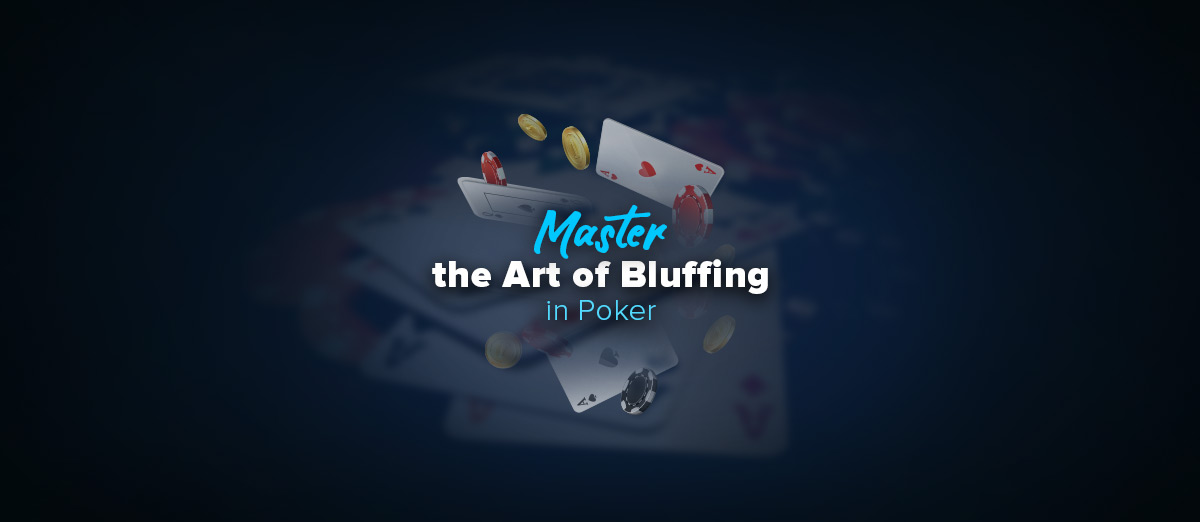How to Pull Off a Bluff – The Ultimate Poker Bluffing Guide with Tips

An old saying in poker goes: "if you never get caught bluffing, you're not bluffing enough." Every good player will tell you this saying holds true, especially as you move up the ranks and come across a tougher competition.
Bluffing is an essential element of poker. While "tight is right," and you can try to rely on poker gods to send some good cards your way, this approach won't make you a big winner in the long run. Sometimes you have to take the risk and go for a pot that doesn't "belong" to you. Of course, there is also the other side of the coin, where some players take things to the extreme, which raises the question, "how often to bluff in poker?" Bluffing way too often is perhaps even more dangerous than not bluffing enough, as it can be a very costly habit.
Mastering the fine art of bluffing in poker takes time and effort, so don't expect to become great at it overnight. That said, in this article, I'll share some useful bluffing tips you can use when deciding what situations provide good poker bluff opportunities.
1. Always Bluff with Some Equity
The best poker bluff example, if you are to believe most poker movies, is when players show up with two completely random cards in big bluff scenarios. They just had the feeling and decided to go for it.
While this can happen every now and again, I'd caution you to avoid bluffing with random hands that have no potential to turn into winners if you get called and have to go to a showdown.
When choosing hands to bluff with, look for the ones that have some chances to improve. For example, check-raising someone with a hand like As2s when there is just one spade on the flop viable, as another spade on the turn will allow you to keep barreling.
On the other hand, this is usually a bad idea if the board reads As Ks Jd, and you decide to start bluffing with a hand like 6c 5c. If you get called on the flop, there are no cards in the deck that can help you on the turn or the river.
You're just hoping that your opponent will give up if you continue barreling, and having a plan that relies on hope alone is not a part of winning poker strategy.
2. Be Mindful of Stack Sizes
How many chips you and your opponent have in front of you is just as important as the cards you're dealt. Being aware of the stack sizes of all players involved in a hand is crucial when deciding whether to bluff or not to bluff.
If you're planning on check-raising someone on the flop, for example, to follow up that with a bet on the turn and a shove on the river, you better be sure your opponent's stack warrants such play.
If they only have 20 big blinds to start the hand, they'll probably just fold or move in on the flop, and your entire plan will fall apart.
This is a fairly common mistake in poker bluffing, especially in live games where reading stack sizes isn't always as easy. Players will often get caught with their hand in a cookie jar, lamenting the fact they didn't double-check their opponent's stack before making a move.
3. Pay Attention to Scare Cards
In Hold 'em, scare cards are the cards that your opponent is likely not thrilled to see. For example, you raise before the flop, and the flop comes with three low cards. You bet, and they call, perhaps holding the top or the middle pair. The turn then brings an Ace.
Whether you have an ace in your hand or not, this is the card that your opponent will rarely be happy to see. As the initial raiser, you're much more likely to have an ace and whatever they had on the flop is now possibly behind.
This is the classic example of a "scare card" peeling off, and if you want to improve your poker bluffing skills, you have to be very aware of this concept.
Another good example is when you call a flop bet on a three-flush board, and the turn brings the flush card. If your opponent checks to you or fires out a small bet, it's probably a signal they are worried and that you can start bluffing.
4. Size Your Bluffs Correctly
If there is one thing that many recreational players don't understand, that's the answer to the question of how to size your bluffs to achieve what you are aiming for.
I've heard it countless times at the tables: "How could you call with that hand," as they mucked their cards, completely oblivious of the fact their river bet was for 15% of the pot.
Your poker bluffs need to hit the sweet spot where they're big enough to make the opponent put their thinking cap on. At the same time, you usually don't want them to be too big as you'd want to get paid if you were actually holding a strong hand.
Of course, like many things in poker, this is very situation-dependent. Against some players, you can get away with very small bluffs as they play a fit-or-fold style. Against some others, you'll have to bet big as they like to take hands to a showdown and won't give up easily with any piece of the board.
Generally speaking, though, you should always put some thought into bet sizing before pulling a bluff. Take a moment to think how much money there is in the pot and how much you'd bet if you had the hand you're pretending to have.
That way, it will be very hard for your opponents to call your bluff, and when you're betting for value, which is exactly what you want to achieve to become the king of the art of bluffing.
5. It’s Alright to Sometimes Give Up
Many players get too sticky with their poker bluffing and miss the signal that it might be time to step on the brakes. Firing on multiple streets and putting maximum pressure on your opponents is fine, but you should recognize when it's time to give up.
Maybe you tried a big check-raise bluff on the flop, followed by an overbet on the turn, and your opponent called. Now, they have less than a pot-sized bet left in their stack, and the river card comes a complete blank.
In these scenarios, you're probably better off checking and giving up on your bluff, especially against competent players. If they know what they're doing, they didn't call your huge turn bet with some weak draw. They are more likely to have a strong made hand already.
If there was a scare card on the river, you could try and go for it, but with a blank peeling off and not too many chips left to play for, chances of pulling a successful poker bluff are really small. As painful as it is to give up and let your opponent win a massive pot, sometimes it's the lesser of two evils. If you shove on the river, you'll likely end up losing an even bigger pot.
Take a deep breath, regroup, and get back to it. There'll be plenty of opportunities later in the session, so don't get stuck on a single hand. It's just one of the thousands you'll get to play throughout your career.
Summary
Mastering the art of bluffing will take a long time. While you can learn many theoretical concepts from poker books and videos, there is no real substitute for the experience. You have to make many wrong moves along the way, and that's perfectly fine. It's all a part of the journey to becoming a good poker player and being able to win at the biggest poker tournaments in the world.
That said, take the tips from this article to heart and have them somewhere in the back of your mind the next time you play. I can guarantee they'll help you in some spots, be it to construct better poker bluffs or to know when it's time to give up.
One final tip I'll leave you with is this: never feel ashamed when your bluff gets called. Aggressive poker is good poker, and players willing to go for it are the ones who make it in the long run. As long as you know your bluffs are sound and make sense, there is nothing you should feel bad about!





Review this Blog
Leave a Comment
User Comments
comments for How to Pull Off a Bluff – The Ultimate Poker Bluffing Guide with Tips